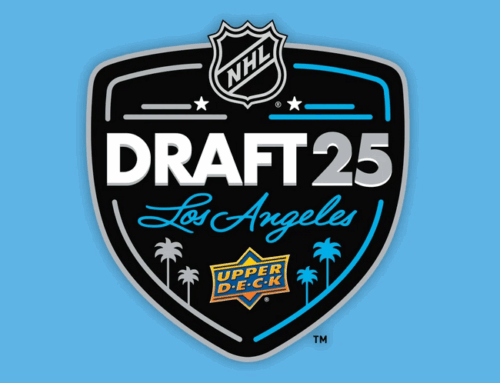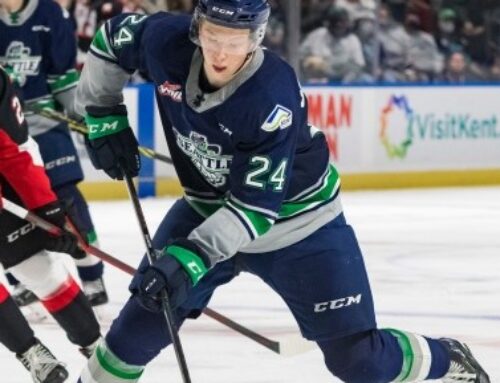Prospect Ramblings: Win vs. Develop, Shelter vs. Trust – Prospect Dilemmas & How the Wings Get It Right
Hadi Kalakeche
2021-11-23
Welcome to my ramblings, where I’ll be writing down my thoughts on NHL and draft-eligible prospects once a week. I’ll be using the ramblings to keep you posted on the week’s events, and let you in on some questions I ask myself often regarding prospects, amateur scouting and player development.
The main question on my mind this week came after a chat with Mikael Nahabedian, known as @hunterofstats on Twitter — Nahabedian works for McGill University’s women’s team and a men’s collegiate team in Québec, using scouting and analytics to further his teams’ performances.
The discussion we had centered around Canadiens prospect Mattias Norlinder‘s utilization in his second NHL game on November 20th, in which he played a meager 11 minutes at five-on-five, without being accorded a single power-play shift. As an offensive defenseman, Norlinder’s strengths of vision, passing and skating often come at the detriment of a decent amount of defensive mistakes, and the rookie blueliner found himself glued to the bench for large chunks of the game despite the Habs being up 5-0 at one point in the match (they ended up winning 6-3, allowing three goals from Matt Duchene while Norlinder essentially sat out the end of the third period — he finished with a +1 on the game).
Is it just me, or is playing a rookie offensive defenceman 11 minutes in a blowout, none of which came on the power-play, just objectively bad?
Norlinder should be in Sweden if this is all the Habs can give him.#GoHabsGo
— Hadi K. Scouting (@HadiK_Scouting) November 21, 2021
While our talk began with the specifics of this situation that Norlinder and the Habs were in, it quickly shifted into a broader discussion on the nature of a player’s confidence, the needs of the team, the needs of the player, and the clash between those three concepts. Nahabedian mentioned that sitting a rookie blueliner when the team is up 5-0, especially since the team is 5-13-2, simply doesn’t make sense from a Win vs. Develop perspective, but he also argued that sheltering can occasionally be very beneficial to a prospect’s game.
The Dilemma of Confidence
When Nahabedian first messaged me to discuss Norlinder’s utilization, I had mentioned to him that I believe some high-skill prospects have a circular confidence/performance feed that makes it detrimental to bench them at the earliest sign of struggle; a prospect of that kind will almost always benefit from going right back out there after a mistake, especially when the score allows it. In a 5-0 blowout going into the second period, with the season the Habs are having, it seemed absurd to me that the Habs continuously sat Norlinder for long stretches instead of giving him more shifts against increasingly better teammates and opponents.
He answered that it’s possible for prospects to be given more than they can handle, which in turn kills their confidence if they’re consistently getting outplayed, citing a player he worked with individually who has a ton of skill but hasn’t figured it out at the team’s current level. The head coach wanted to play them in the top-six forward group, but Nahabedian recommended they play on the third line, where the competition won’t be as fierce but the forward’s linemates will be athletes who already have adapted to the league’s game and pace of play. As a result, the prospect’s confidence can be built up by not constantly having terrible shifts against the opponent’s best.
The other benefit of sheltering a prospect is removing as much pressure as possible. In a case where the prospect hasn’t shown the tendency to manage pressure well, they can be placed in a support role, and not be asked to be the primary play-driver on a team that they’re not ready to take over yet. Another benefit, which doesn’t apply in this specific instance, is favoring a winning product for the organization.
With situations like these, I believe that a proper evaluation of the prospect’s mindset can help dictate the proper course of action; some prospects work better with sheltered minutes and slow, gradual confidence-building before they can take over top minutes, but others need the wheel to be spun by their coaching staff first. Show them trust, pat them on the back and have a constructive talk with them on the bench about what they could do better, while making sure they know that they’ll be back out there in three minutes tops.
The better course of action would then depend on the prospect’s inherent reactions to both pressure and adversity; sport psychology is often an underrated aspect of drafting, developing, and retaining talent.
This scoring chance doesn't happen without Norlinder. He rushes past Sidney Crosby (!) and carries the puck through the NZ, dishes off, goes to the net, ties a stick up, and then Dvorak happens #GoHabsGo pic.twitter.com/s4hqJicEd0
— Hadi K. Scouting (@HadiK_Scouting) November 19, 2021
What’s for sure is that essentially benching a prospect when you’re up 5-0 does nothing constructive for their confidence. For the amount of net-negative defensive plays that Norlinder performed, there were similar amounts of net-positive offensive plays that he performed that I’d argue no other blueliner on the Habs roster is equipped to make at the moment. He got lost on a couple of plays when defending in-zone and didn’t look as sure of himself as he usually is on zone entry denials, but wasn’t atrocious to the point of deserving the least amount of ice-time on the entire team. Rarely does a defenseman figure last on their team’s TOI sheet.
No matter how good Chris Wideman is, a 21-year-old rookie offensive defenseman should be out there instead of him on the power-play when the team is up by three, four or five goals. When all Jeff Petry seems to be able to do is fire wristers from the point into opponents’ shin guards (and when he only has two assists in 20 games while manning the team’s first unit every game), Norlinder should absolutely get a try. Even Ben Chiarot got a shift on the power-play while the rookie blueliner sat out the Habs’ two man-advantages. Cole Caufield was restricted to 13:55 in that game as well, of which only 31 seconds came on the power-play.
With that, I wanted to take a look at a team that is doing an excellent job with their prospects’ deployment.
Detroit Red Wings — Develop > Win
One option, when you’re coaching a young team, is to favor development over playoff hopes; almost by definition, this requires a rebuild to happen — the exception being if your youth core is insanely, outlandishly good. The Wings have been clear on their intention of rebuilding a successful roster through the draft since Steve Yzerman took over, solving the need-to-win part of the equation. What do they make of their youngsters, then?
Well, Moritz Seider has never played less that 18:59 so far this year. His highest TOI came on October 29th, three weeks into his rookie campaign, when he totaled 26:51 in a 3-2 overtime loss to the Florida Panthers. He started the year on the team’s second pair, and quickly earned his way onto the first with stellar offensive and defensive performances, leading him to 13 points in 20 games and the team’s only Star rating in Dom Luszczyszyn’s Game Score Value Added (GSVA) depth charts — a measurement that approximates a player’s overall impact on the team’s win column.
Seider has broken into the Star level category via Doms GSVA depth charts. https://t.co/TrqvNPIVav pic.twitter.com/hhsH7LBli2
— Beer League Chump (@YzermanSZN) November 15, 2021
Lucas Raymond, on his end, has averaged around 17 minutes a game and only dropped below the 14-minute mark three times this year, with a high of 19:57, earning the highest GSVA rating on his team with 2.3. He’s also been stapled to the top line with the Wings’s two most offensively-gifted forwards, Dylan Larkin and Tyler Bertuzzi. The team also has Filip Zadina and Joe Veleno playing for them, both of whom are 21 years of age — the former has reached 17 minutes or more four times this year, and the latter has been struggling with outright poor performances while the team gave him as much as 15:52 at times to show his worth.
The Wings have nothing to look forward to playoff-wise, and have accepted that fate. They’ve allowed themselves to find their rookies spots in the lineup in which they can flourish, and have stuck with most of them through thick and thin, playing Raymond and Seider on their top power-play unit since the start of the year. Their transition to the NHL has been seamless, and their level of skill has been key in that aspect, but the allocation of ice-time, the trust despite their mistakes and especially the fact that the whole team is on the same page regarding their objective this year, lead to a flourishing youth movement.
Thanks for reading — follow me on Twitter @HadiK_Scouting for all of your fantasy prospect needs!





